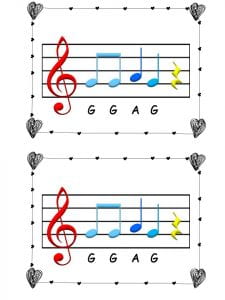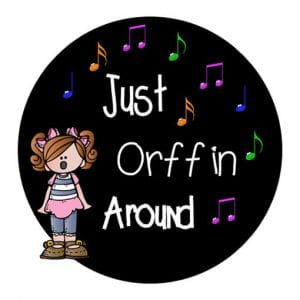I will be honest with you, I have never been a big fan of “Valentine’s Day” themed music activities. They just never felt authentic to me. However, with Valentine’s Day right around the corner, I stumbled on a sweet little melody to the following poem:
Roses are Red
Violets are Blue
Sugar is Sweet
And so are you.
It came from a great resource by James Harding:

I wish I could meet James Harding. His sense of humour shines through every page of his book. If you haven’t purchased it yet, you are really missing out.
Back to the roses…

We are having so much fun with this. Here is the process I followed:
Day 1
- Intro the melody by rote.
I use a cone puppet for echoing. When he is in they listen, when he pops out they echo. Level 1- echoing one phrase at a time; Level 2 – echoing 2 phrases; and Level 3 – Sing it together.
- Intro the “Staring Game.”
This is a partner game. They skip away from their partner and return by the end of the song for a staring contest. If they blink, move, or look away, they both sit down. We play to see who is the last couple standing. I have 2,3,4,5,6 way ties if it feels like it is going on too long.
- Mirror the Bass Xylophone accompaniment. Transfer to pitched percussion.
For the Kindergarten, I don’t teach them the Bass Xylophone Bordun.
For the grade 1’s, I teach them a solid bordun – both hands coming down at the same time on the C and G.
For the grade 2’s, I teach them a broken bordun – they alternate the C and the G.
For the grade 3’s, I add the arpeggiated bordun on the last phrase. (As notated above)
Day 2
Pre-set the instrument circle.

You can use any pitched and non-pitched percussion that you have. My circle usually has approximately 22 to 25 instruments. I alternate pitched and non-pitched percussion so their role changes as they move through the circle. The pitched percussion are set up in C pentatonic.
- Intro the color and non-pitched percussion parts through Body Percussion.
I have them pat the glockenspiel part and clap the non-pitched percussion part. It goes without saying that you sing the song as you practice the body percussion and anchor it to to the lyrics – “Pat” after the colors; “Clap” on “So are you.”
- Transfer the body percussion to the pitched and non-pitched percussion.
If they are at barred instruments, they play a tone cluster on the pats. If they are at a non-pitched percussion instrument, they play on the claps.
For my kindergarten and grade 1’s, they all play on “So are you”.
- Intro the vibraslap.
We add this cool sound effect after the word “you.” So much fun.
It is difficult for the kindergarten and grade 1’s to play the vibraslap independently. I leave it out of the rotation.
- Rotate through until everyone has a turn at everything.
A video is worth a thousand words. Here is a little clip of my students playing the game.
Grade 2’s
Day 3
I wanted to focus on some melodic reading so we extended the song into the following two activities.
Kindergarten and Grade 1’s – Read a short melodic pattern using “High” and “Low”
- Intro the melodic contour cards.
I created these little visuals to use.



We sat together and read them quickly using “High” and “Low”
- Chose students to model play the patterns on the bells.
I color coded them to match our little bells.

- Intro the “Roses are Red” circle game.
As you sing the song, pass a ball around the circle. Whoever is holding the ball at the end of the song goes to the middle and plays the melodic pattern on the bells. Continue playing.
Grade 2’s and 3’s – Students will be able to play the melody on the pitched percussion.
This was fun today. We played guess the mystery song and I gave them clues.
- Clue 1 – Read the rhythm. I had notated the phrases, rhythm, and double bar line. They read the rhythm and I gave them their first guess.
- Clue 2 – Echo sing one phrase at a time using solfege. Guess #2.
- Clue 3 – Echo sing two phrases at a time using solfege. Guess #3
- Clue 4 – Echo sing the entire song using solfege. Guess #4. Hopefully by now they have it.
- Clue 5 – Sing with the words.
Once they have identifies the song we do the following.
- If doh is C what is …
We connect the musical alphabet to the pitch syllables.
- Sequence the melody.
I have these cards to sequence the song.


- Sing the song with note names.
- Practice playing the melody with a partner.
I gave them the music and they practiced. By the end of class, they played the melody and I accompanied them on the Bass Xylophone. It was really satisfying for them.

I do color code as a visual support for some of my students who struggle. We have little coloured stickers on our pitched percussion that match the little bells. Is it really music literacy? I think so.
This post has lots of goodies. I hope you try one of them out. They all can stand alone. Happy Valentine’s Day!!!!
Take care,
Syndi
